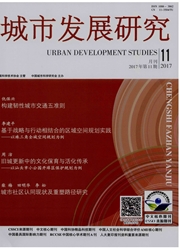

 中文摘要:
中文摘要:
城市管理者寄望以通州"城市副中心"建设缓解北京中心城区产业与人口的过度集聚,有效优化城市空间结构、带动京津冀协同发展。但通州区作为北京最早确立的重点新城之一,并未能摆脱产业发展滞后、"有城无业"的"卧城"形象。为弥补定性分析的不足,采取多元回归、面板模型等定量方法对2000~2010年通州区产业发展特征进行剖析,发现其产业发展依赖工业与房地产的双轮驱动,但工业产出边际效益低,区域内部存在产城错位现象;以土地利用类型衡量,产业发展要素投入不足等特征。进而,提出了构建现代产业体系的若干政策建议,以期更好指导通州"城市副中心"建设。
 英文摘要:
英文摘要:
Building " The Urban Sub-center" of Tongzhou district is an important task for local government in Beijing,which aims to relief the over-concentration of industries and populations in urban center,also to optimize the urban spatial structure and mobilize the synergetic development of Beijing,Tianjin and Hebei. Nevertheless,industry development level is low in Tongzhou district and it been deemed as " dormitory town",though it's an important new city designed in Beijing urban planning several years ago. In this paper,we use quantitative model to analyze the characteristic of industry development in Tongzhou district from 2000 to 2010,and the results are as following: Industry development in Tongzhou district is driven by manufacturing and real estate,however the marginal benefit of manufacturing is low,and there's spatial mismatch between urban and industrial layout. The input of industrial development factors is poor according to the study of land use change. Furthermore,we propose some suggestions to build an modern industry system,which is helpful to the construction of " The Urban Sub-center" of Tongzhou district.
 同期刊论文项目
同期刊论文项目
 同项目期刊论文
同项目期刊论文
 期刊信息
期刊信息
